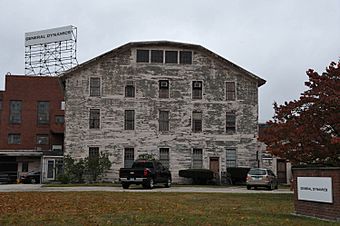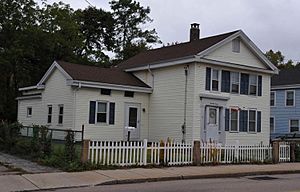Mechanic Street Historic District facts for kids
Quick facts for kids |
|
|
Mechanic Street Historic District
|
|
 |
|
| Location | Roughly bounded by W. Broad St., Pawcatuck River, Cedar St., and Courtland St., Stonington, Connecticut |
|---|---|
| Area | 147 acres (59 ha) |
| Architect | Pendelton & Hall; Et al. |
| Architectural style | Late 19th and 20th Century Revivals, Greek Revival, Late Victorian |
| NRHP reference No. | 88000653 |
| Added to NRHP | June 7, 1988 |
The Mechanic Street Historic District is a special area in Pawcatuck, a part of Stonington, Connecticut. It's like a time capsule, showing what a mill town looked like in the 1800s. This district covers about 14 city blocks.
It stretches along the Pawcatuck River and is south of West Broad Street (U.S. Route 1). The district includes a large brick factory complex right by the river. It also has a neighborhood with many well-preserved homes where the factory workers used to live. This historic area was added to the National Register of Historic Places in 1988. This means it's recognized as an important place in American history.
Discovering the Mechanic Street District
The Pawcatuck area of Stonington, along with nearby Westerly, Rhode Island, grew as a busy port in the early 1800s. It was a place where ships were built and goods were traded. Many shipyards were located along the Stonington side of the river.
The homes for the shipyard workers were some of the first buildings in the residential area to the west.
How Industry Shaped the Town
When the railroad arrived in 1837, it brought new industries to the area. A foundry, which is a place where metal is melted and shaped, opened in 1851. A machine factory followed in 1857. This factory later became famous for making printing presses.
Later in the 1800s, a textile mill also opened. Textile mills are factories that make cloth. As these businesses grew, more and more workers were needed. To house all these new workers, many different types of homes were built nearby. Both the factory owners and other people built these houses.
Exploring the District's Size and Style
The historic district is about 147 acres in size. It is bordered by West Broad Street to the north and the Pawcatuck River to the east. The district includes a large factory complex right on the waterfront. This complex has seven main buildings spread over about 25 acres. There is also a smaller office building for the company.
The district extends westward from the factory complex to Courtland Street. The area beyond the railroad tracks is mostly made up of worker housing. The homes in this residential area have many different styles. Some are Greek Revival homes from the early shipyard days. Others are tenement-style buildings built later in the 1800s. These different styles show how the town grew and changed over time.




